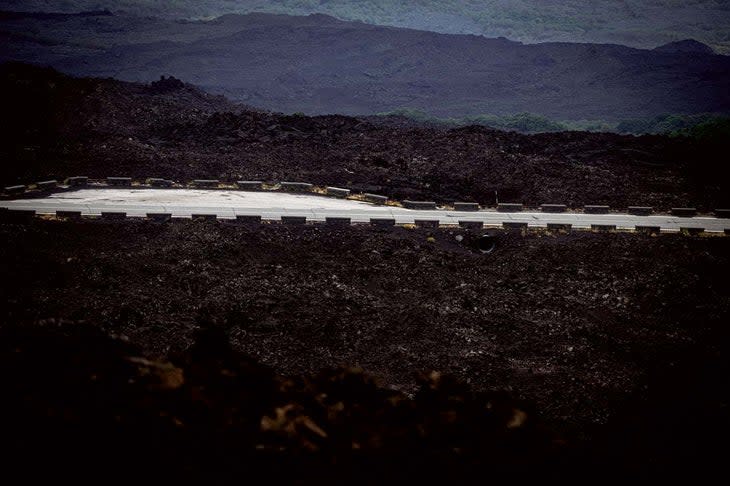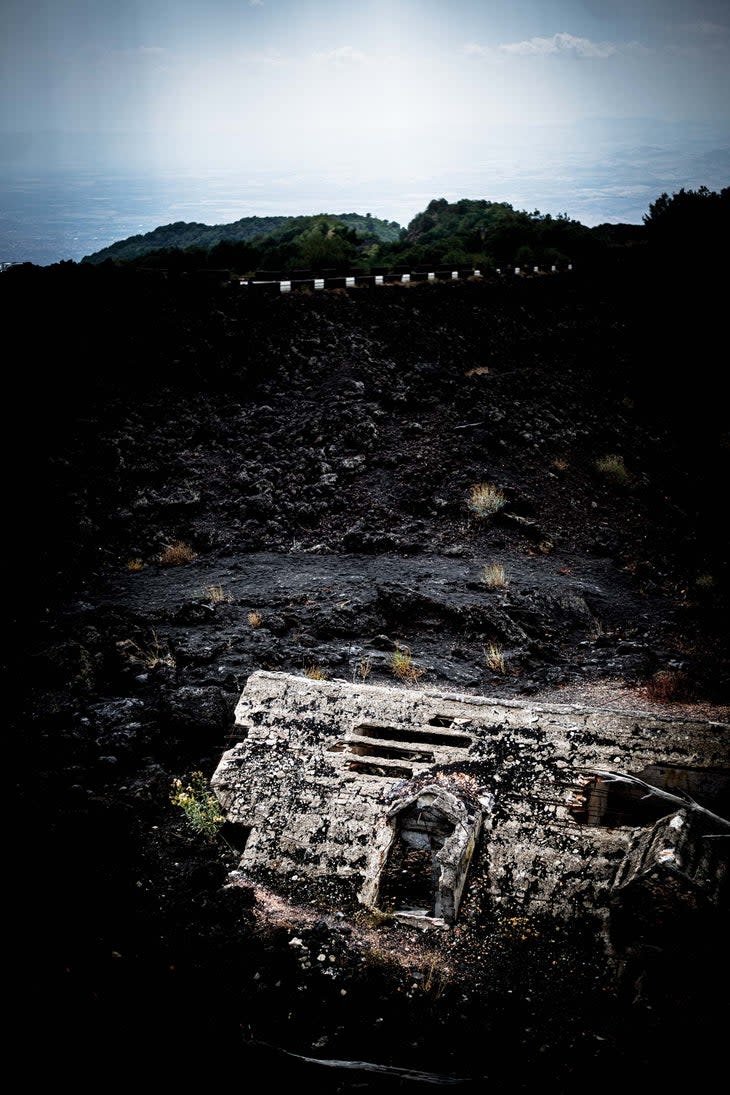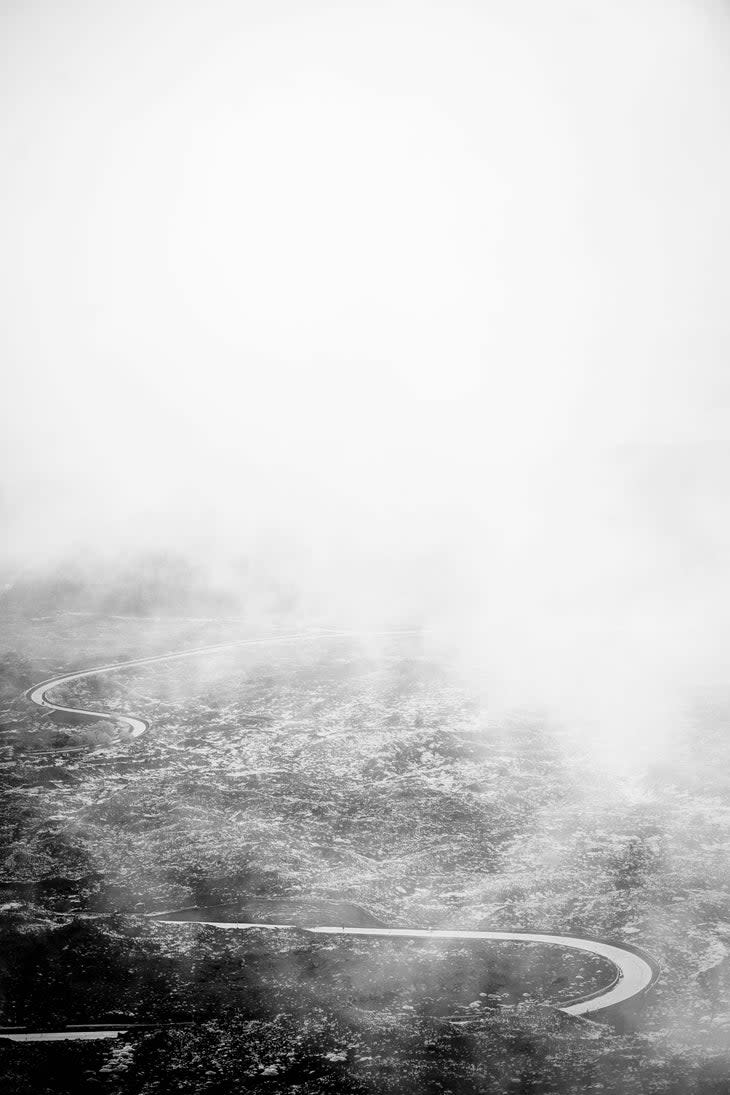Lava & Legend
This article originally appeared on Peloton Mag
As a sport, cycling is both innovative and adventuresome. It discovers little-known places and secrets of the landscape and embraces them into its own mythology. Think of the iconic mountains of the grand tours, such as the Izoard, Alpe d'Huez, Mortirolo and Angliru. These places were not famous until cycling came along and blessed them with its colorful drama. Mount Etna, however, is a different beast. It doesn't need cycling. IT IS OLDER AND BIGGER AND MORE DANGEROUS THAN ANY PUNY BIKE RACE. Foolish men may choose to pedal their shiny machines across its lava-blackened slopes but this Giant of Sicily cares not. And the stories of the Giro d'Italia's Etna stages are mere whimsy compared to the stories previously told about the volcano.

This year, the Giro takes on Etna once again. After the transfer from the Grande Partenza in Hungary, stage 4 on May10 gives the peloton an early taste of gravity--and quite possibly a taste of lava too. Starting in the small seaside town of Avola, this first stage on Italian soil runs north for over 100 kilometers, crossing the open plains of southern Sicily. By the time the riders get to the town of Paterno, at the foot of Mount Etna, they will already be climbing. At that point there will still be 39 kilometers to ride--20 kilometers of false flat, just to warm up the legs before the official climb, which is 19 kilometers long with an average gradient of 7 percent.
The stage finish is at Rifugio Sapienza, a ski station at 1,892 meters (6,207 feet) above sea level. The summit of Mount Etna is considerably further into the clouds, at 3,357 meters (just over 11,000 feet). For the climb's final kilometers, the smooth gray ribbon of asphalt snakes across expansive black fields of volcanic ash. Rather like Mont Ventoux, the trees that populate the lower slopes drop away, fully exposing the riders to the elements. It is a brutal climb and coming so early in the Giro, it could break the hearts of those with designs on the maglia rosa.
The last time the Giro climbed Mount Etna, on a rare rainy day in 2020, the race took on the volcano from the northeastern side (traditionally it uses the southern roads) and early on the climb the two British contenders Simon Yates and Geraint Thomas cracked. Ecuador's Jonathan Caicedo took the win that day. Etna has proved a happy hunting ground for South American riders; two years earlier Colombia's Esteban Chaves won here.
The first time the Giro visited Etna was in 1967. The race that year started in Treviglio, near Bergamo, and during the first week ran down the western side of the peninsula, through Tuscany to Rome, then down to Naples and a long boat trip across to Sicily. After a circuit race on the Monte Pellegrino circuit in Palermo the race convoy undertook a painfully slow train journey across the island to Catania, the town that lies at the foot of Etna. The riders were not impressed. In protest at the lengthy transfers--more common in grand tours today, then a novelty--they rode slowly as a pack for nearly the whole stage. Only in the final 3 kilometers of the Etna climb did they allow some action, and by then it was too late to create significant time gaps. The organizers' grand plan to introduce a mythological new place to the Giro had backfired. Scarred by the experience, it was to be 22 years before the Giro next tackled the mountain.
When the Giro visits Sicily, it's usually within the first week because the race invariably finishes in the north of the country. So Etna, tough as it is, can only be a prelude to the later mountain stages. It's a cruel fate for such a proud mountain. One gets the sense that Etna is waiting for the right moment to exact revenge on the organizers, in its own inimitable style.
But just how dangerous is the volcano?
Mount Etna is one of the most active of what are called stratovolcanoes in the world. Volcanic activity in the region dates back half a million years, to when eruptions occurred under the sea off the Sicilian coast. Around 170,000 years ago the activity shifted to the current location of the peak and its craters. Over time the continual eruptions of lava built up the mountain that we see today. There are five principal craters at the summit. These produce the most spectacular vertical eruptions. Being so high and far from inhabited buildings, however, means that these eruptions are rarely dangerous. More threatening are the many vents that line the flanks of the volcano. Eruptions through these vents are not spectacular (think oozing rather than spouting lava) but they can occur anywhere, and many of the vents are close to roads, villages and ski resorts.
Volcanic activity on Etna is almost constant. There is always something brewing. The biggest eruptions have the power to reshape the mountain's summit, throw up huge clouds of ash or bury houses. Since 2000, Etna has seen four major flank eruptions and six summit eruptions. One of the largest was in 2002. A column of ash plumed into the air and could easily be seen from space. Seismic activity made the flanks of the volcano shift by 2 meters, undermining the foundations of many houses in the area. The ski stations at Rifugio Sapienza and Piano Provenzana were both buried in ash and had to be rebuilt. Considering the devastating power of the volcano, death or injuries on Etna are rare. Volcanic activity can be predicted by the Sicilian authorities using specially designed monitoring devices to detect pre-eruption levels of specific gases. So, a cartoon-like image of cyclists desperately trying to outpace a surprise lava stream remains unlikely.
Which is not to say that Mount Etna is not an intimidating and eerie place. As recently as early February this year an eruption propelled ash 10 kilometers into the air and created a violent volcanic storm, with lightning crackling across the night sky. Etna does not need cycling's mythology. Its awesome power has inspired the mountain's own, far more ancient, stories--such as the Roman god of blacksmithing, Vulcan, having his forge beneath the mountain. In Italian the volcano is known as Mongibello--literally. beautiful mountain.

Readers familiar with Arthurian legends may recognize the name Mongibel as the home of King Arthur's halfsister, the charismatic and powerful enchantress, Morgan le Fay. Mongibel appears in a 13th century Arthurian romance, “Floriant and Floret,” written by an anonymous author, the manuscript of which resides in the Archives and Manuscripts Division of the New York Public Library. It seems odd for a story about England's King Arthur to involve Sicily; the explanation lies in the fact that the Normans and their neighboring Bretons co-opted Arthurian legend into their own literature. Arthurian legends later became blended with Sicilian folklore during the Norman conquest of Sicily in the second century A.D.
In the story, Floriant, son of the King of Sicily, has had the misfortune of being dispossessed of his inheritance by a disloyal house steward who kills his father and lays siege to his mother. Abducted at birth by Morgan le Fay, Floriant is kept imprisoned in her secret castle, Mongibel, until he is 15. He then sails away from Sicily on an enchanted ship, eventually landing in Britain where he becomes friends with King Arthur. In Britain, Floriant learns the truth about his parents and, vowing to avenge his father and free his mother, returns to Sicily with King Arthur's fleet.
Several battles ensue. The treacherous house steward and his sponsor, the Emperor of Constantinople, are resoundingly beaten. And Floriant even finds time to fall in love with the emperor's daughter, Florette. Floriant is crowned King of Sicily and Emperor of Constantinople to boot. He lives happily with Florette for many years. He then succumbs to pride and vanity, going off fighting again when there is no need to do so. Finally, he returns to Sicily to settle down with Florette.
One day, while hunting, Floriant follows a shining white deer up Mongibel and into a castle at its summit. There he finds Morgan le Fay, who tells him that he will soon die. Le Fay sends three fairies to fetch Florette. After that no one ever sees Floriant or Florette ever again.
Is there a moral in this tale for the brave knights of this year's Giro d'Italia? Perhaps team leaders should be keeping a close eye on their supposedly loyal domestiques. Perhaps the climbers should measure their efforts and not engage in foolish attacks. And if, after the finish line, an exhausted rider is offered a goblet of recovery drink by a beautiful woman with wild red hair and flowing green robes, he really should check whether she has the right accreditation.

For exclusive access to all of our fitness, gear, adventure, and travel stories, plus discounts on trips, events, and gear, sign up for Outside+ today.

